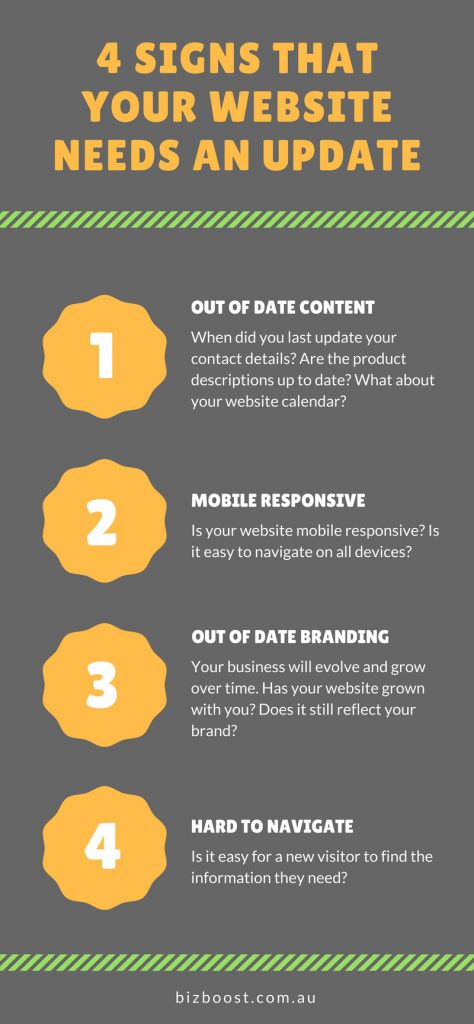 As you might expect, a website is not an investment that you can just “set and forget”. After it has been built, it takes work in order to update and maintain it.
As you might expect, a website is not an investment that you can just “set and forget”. After it has been built, it takes work in order to update and maintain it.
With that in mind, here are four signs that your website is overdue for a bit of work.
It hasn’t been updated in a long time
Is all the information on your site still up to date?
Your website is a representation of your business and what you can offer potential customers or clients. Having old or out of date information can give visitors the impression that what they are looking at is stale. Even worse, it can give a subliminal message that you “don’t care” or are “too busy to keep up”.
Also, Google can tell how frequently you update your website and this can play a role in where you rank in the search engines. The theory is that a regularly updated site is more likely to be relevant for the searcher then one that hasn’t been touched in over a year.
It’s Not Mobile Responsive
You may have noticed that we seem to mention mobile responsiveness in almost every article we write. Why? Because it’s REALLY important.
What is it?
Having a mobile responsive site means that each page adapts automatically to suit the size of the screen it’s viewed on. In other words, a single page can be displayed differently on a laptop compared to a mobile phone.
When Bizboost first opened its doors, using a mobile device to search the internet was uncommon. As such, web developers only had to worry about making a website function on one screen. Over the past five years, there’s been a huge increase in the number of mobile devices available and the ease in which we can use them to browse the internet. Now we’re dealing with phones, tablets, laptops and desktop computers (and each brand has a different sized screen).
Why is it so important?
User experience matters on a subconscious level. You might not realise it’s happening, but if the information on a page is hard to read or scroll through, less attention is paid to its content.
Google also pays attention as to whether your website is mobile responsive and uses this information when deciding where to rank you in the search engine results. As always, Google’s goal is to create the best user experience for the searcher. If they are browsing from a mobile device, Google will prioritise websites that have been optimised for that screen.
Your Brand Has Evolved Since Your Website Was Created
Branding is everything in marketing. If your business has been around for 5, 10 or even 20 years, I’m willing to bet that the branding you use has evolved over time.
You also want that branding to be consistent across all aspects of your marketing, including your website.
In this case, I’m not just talking about the overall design of the website (although that is also important). Branding also includes the pictures and content you have on each page. Do they represent your current business persona? Are they giving your website visitors the right impression?
It’s No Longer Easy to Navigate Your Website
Think of the most important things a visitor may need to know when they reach your website. This may include:
- The products/services that you provide
- The fantastic benefits of the products/services you provide (e.g. product descriptions, statistics, testimonials, client success stories).
- Your location, or any other details they might need to get their hands on the products/services you provide
When a visitor arrives on your homepage, can they easily find all this information? Or do they need to click through multiple links to find it?
If you’ve read any of the points above and thought, “yep, that applies to me”, then it might be time to update your website. If you have any questions or would like assistance in doing this, give us a call or send us an email. We’re always here to help.











